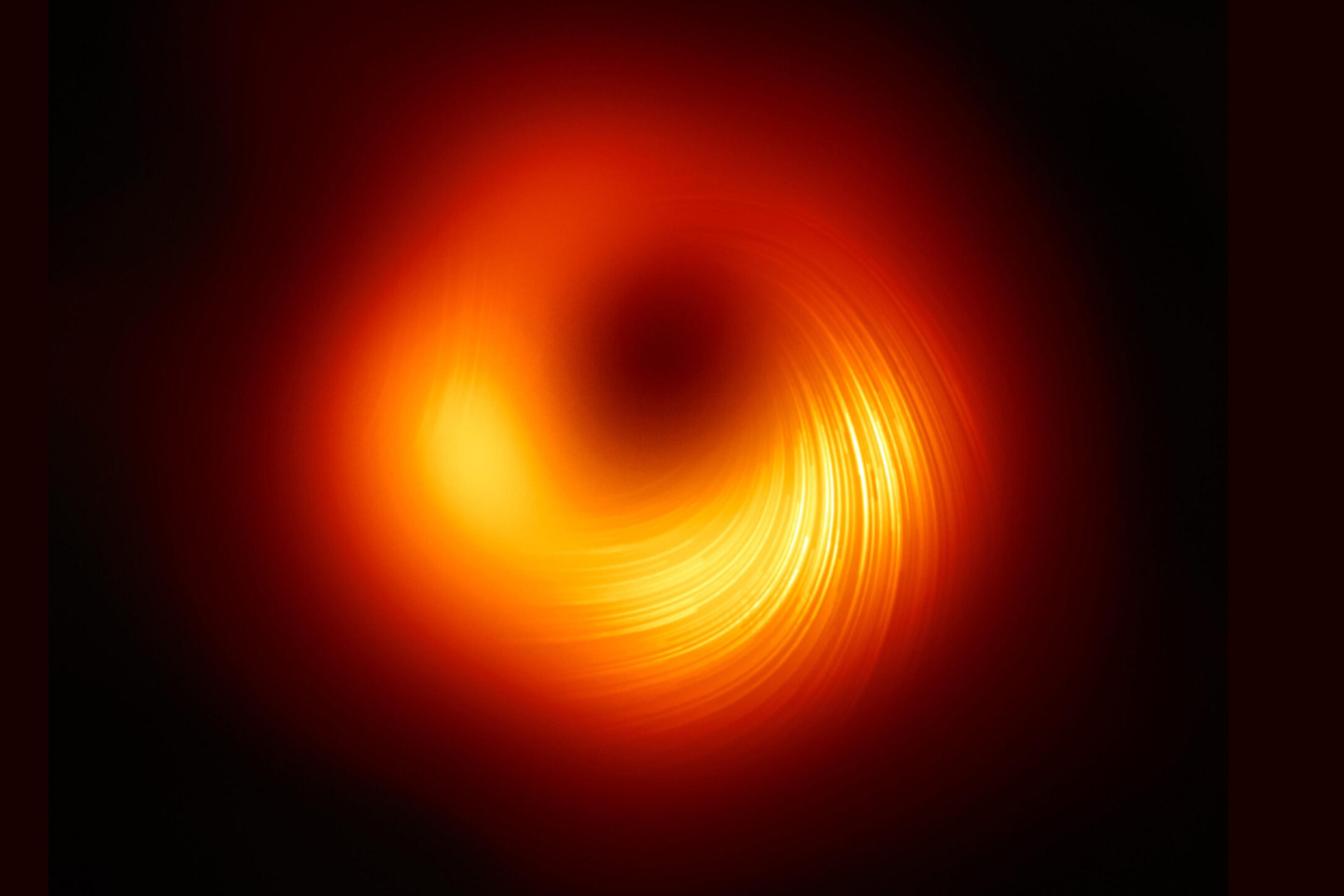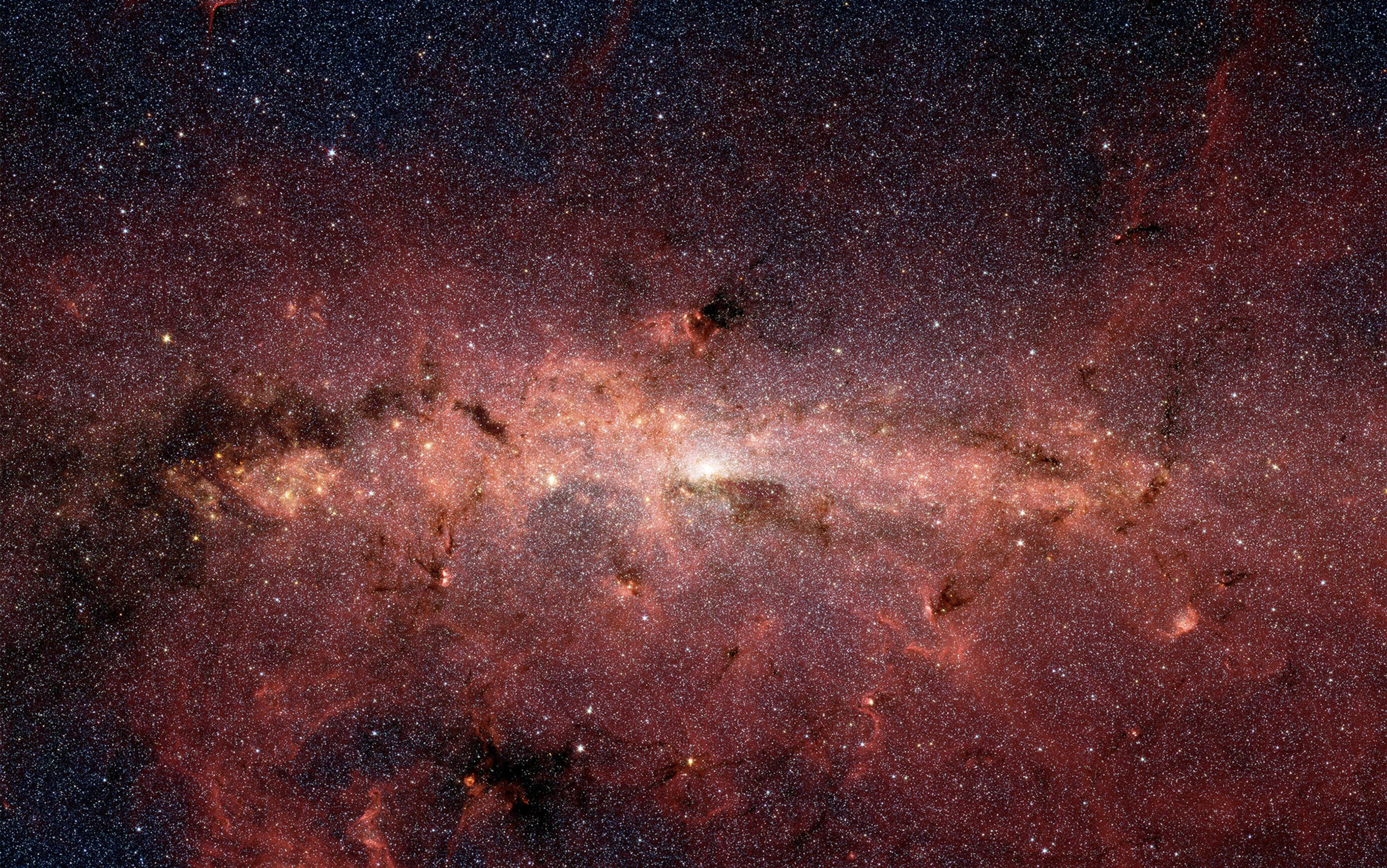This was an equation to die for. That became clear when I turned up at Stephen Hawking’s 60th birthday celebrations in Cambridge in 2002. Reminded of his mortality by a hip-cracking collision with a wall in his motorised wheelchair a few days earlier, ‘aged 59.97’, he declared in his well-known synthesised voice: ‘I would like this simple formula to be on my tombstone.’
The year 2024 marks the 50th birthday of Hawking’s formula, which is a milestone in scientific theory and reveals a truly shocking aspect of black holes. After his death in March 2018, aged 76, the formula was engraved in stone in Westminster Abbey, and his office and its contents donated to the nation in lieu of inheritance tax. Sifting through Hawking’s personal possessions, my colleagues at the Science Museum in London have uncovered evidence of the formula’s profound influence: it featured on papers, written bets that Hawking made, mementos, even a silver beaker presented to him by the producers of the Hollywood biopic The Theory of Everything (2015).
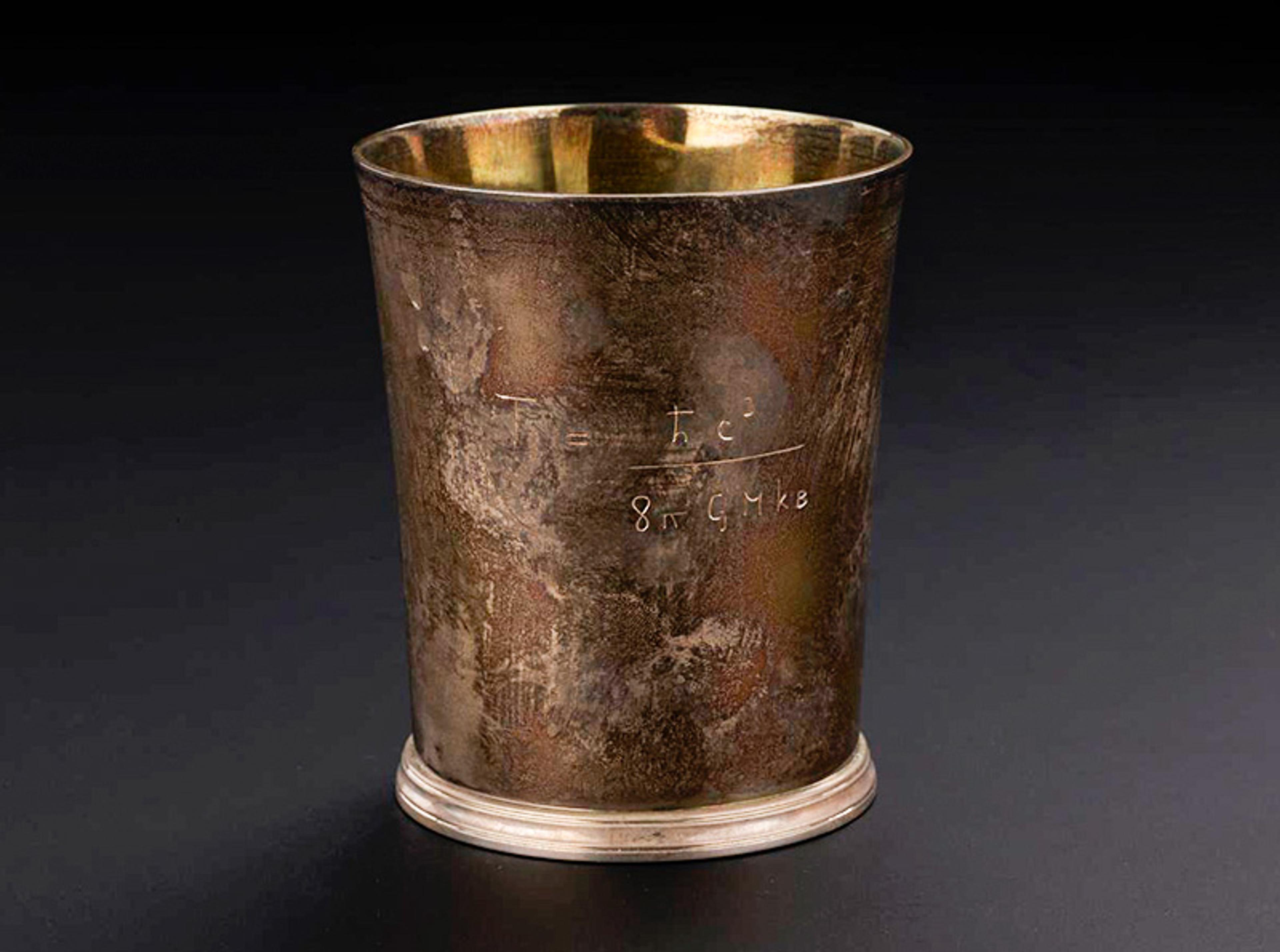
Silver beaker engraved with the mathematical formula for Hawking radiation. Photo © The Board of Trustees of the Science Museum
The subject of the equation, the most extraordinary of all cosmic entities, had materialised in the minds of theoreticians centuries before there was a shred of evidence that they even existed. In 1783, John Michell, a country parson in Thornhill, near Leeds, had mulled over what he called ‘dark’ stars, based on Sir Isaac Newton’s ideas, which envisaged gravity as a force and light as corpuscular, that is, consisting of particles: light particles seething from a stellar surface would have their speed reduced by the star’s gravitational pull, similar to when a bullet is fired skyward from Earth. And if a star’s gravity were sufficiently strong, Michell realised that the light would fall back to the surface.
Though this captured the gist of a black hole, Michell was wrong in key respects: general relativity, Albert Einstein’s 1915 theory of gravity, rests on the assumption that the speed of light is constant. It doesn’t envisage gravity as a force, but as a warping of spacetime, a fusion of space and time. Our Earth, for example, warps the Universe this way, and satellites orbit along the resulting curves. This is what we experience as gravity.
Just after Einstein had published his theory, the physicist Karl Schwarzschild, then a German artillery lieutenant, used Einstein’s equations to envision spacetime that was so wildly warped by a concentrated mass that it is invisible, though his conclusion gained little traction. In 1939, the American theoretical physicist J Robert Oppenheimer, before he became ‘destroyer of worlds’, and while working with Hartland Snyder, showed how a spherical cloud of dust could collapse into a region from which light couldn’t escape. This work did not convince their peers either but, as astronomers began to find evidence of super dense objects, it was followed up decades later by the British theoretical physicist Roger Penrose.
In 1965, Penrose showed that black hole formation was indeed a robust prediction of Einstein’s general theory of relativity, and even went on to speculate about how to extract energy from a black hole by what became known as the Penrose process. Soon after, the term ‘black hole’ was coined by the Princeton physicist John Wheeler, though Penrose would have to wait more than half a century before his work was recognised with a Nobel prize.
At long last, experimentalists caught up with what the mathematics predicted: Penrose shared the 2020 Nobel Prize in Physics with Reinhard Genzel and Andrea Ghez, who since the early 1990s had focused on a region in our galaxy called Sagittarius A*, harnessing the world’s largest telescopes to peer through clouds of gas and dust at the centre of the Milky Way to provide ‘the most convincing evidence yet’ that a supermassive black hole lurked there.
Penrose’s experience does at least answer the riddle of why Hawking never won a Nobel: we’re still waiting for experimental evidence to support the implications of his equation, which he called ‘my most surprising discovery’, one that casts black holes in a whole new light. As Hawking put it, ‘black holes ain’t so black’: they glow. Today, his half-century-old equation explaining why this is so has become more than a landmark in scientific theory: it is a beacon for efforts by physicists to discern the fundamental laws of the Universe.
In his biographical note in Hawking’s Order of Service, Penrose acknowledged that the equation was Hawking’s most important contribution: ‘[H]e was able to provide the one clear-cut physical implication, that we know of, which brings together the two great revolutions of 20th-century physics, namely general relativity and quantum mechanics …’ We have already encountered general relativity, a theory of gravity, which shapes the large-scale structure of the Universe. Quantum mechanics, which Einstein also had a hand in, explains how extremely small objects simultaneously, and paradoxically, act like both particles and waves.
Both rest on arcane mathematics. Yet these great theories seem at first glance to be incompatible, with one describing the subatomic realm as a domain of individual particles, or quanta, where there are sudden jumps, and the other ruling the grandest stage of all, the Universe, in terms of smooth distortions, undulations and warps of spacetime. Uniting them meant more than trying to reconcile languages as dissimilar as Morse Code and whalesong, however: while general relativity is deterministic, quantum mechanics is couched in terms of chance.
He predicted correctly that ‘all black holes – even ones that don’t rotate – continually emit radiation’
To bridge the two, Hawking ‘really needed a quantum theory of gravity,’ Graham Farmelo, his official biographer, told me. ‘There was no such theory, so he resorted to a judicious combination of quantum field theory, which depicts particles as excitations in underlying fields, and Einstein’s theory of gravity. This required outstanding intuition, great technical skill, and mathematical ingenuity.’
Farmelo continued: ‘Within a few weeks, he had completed the calculation in what was later regarded as a tour de force, enabling him to predict correctly that all black holes – even ones that don’t rotate – continually emit radiation. Amazing!’ Today, Hawking’s equation remains the one result in attempts to reconcile quantum mechanics and gravity accepted by the entire community of physicists working on the subject.
Hawking had to overcome more than technical obstacles. He faced a brutally practical challenge – the ravages of his motor neurone disease – which had taken a heavy toll since 1963 when, at the age of 21, he was told by doctors he’d have only two more years to live.
His old friend Martin Rees, now Lord Rees and the Astronomer Royal, described how, by the early 1970s, ‘Steve’ was disturbingly frail. When Hawking asked for an abstruse book on quantum theory to be opened before him, Rees was struck by how he was unable even to turn the pages himself: ‘I wondered what was going through his mind, and if his powers were failing,’ Rees wrote in The Independent in 2018. Yet, he added, that was precisely when Hawking came up ‘with his best ever idea’.
By then, Hawking had honed a remarkable skill to do mathematics without pencil, paper or formulae, according to Kip Thorne, his old friend at Caltech in the US, where Hawking was a frequent visitor. In his Westminster Abbey tribute, Thorne described how Hawking ‘manipulated, in his mind, images of geometric shapes: of ribbons, curves, cubes and spheres, and topological images, like a coffee cup deforming into a donut. His flowing mental images gave him insights nobody else could find.’
His ‘area theorem’ predicts that the area of a black hole’s event horizon should never shrink
The first step towards his equation came in 1970, a few days after the birth of Hawking’s daughter Lucy, as he began the laborious process of getting into bed. He realised ‘first of all how to define a black hole in a more mathematical sense than its colloquial sense,’ explained Gary Gibbons, his student at the time. Using tools developed by Penrose, Hawking ‘defined what we call the event horizon’, a veil that shrouded the inner workings of a black hole.
Another idea of Penrose’s set Hawking thinking about what happens when black holes collide, at a time when he was mulling over the ripples in spacetime – gravitational waves – radiated by these violent encounters. This would set the stage for his ‘area theorem’, which predicts that the area of a black hole’s event horizon should never shrink. This defies everyday experience: we would expect the resulting surface area of two merging objects, from stars to raindrops, to be less than the sum of their parent areas.
Hawking came up with that insight in 1971 and it was eventually confirmed decades later, after the huge Laser Interferometer Gravitational-wave Observatory (LIGO) on Earth first picked up gravitational waves from two merging black holes. Hawking, on hearing the result, contacted Thorne, LIGO’s co-founder, to see if it could support his theorem. The answer was yes: analysis revealed the event horizon had indeed swelled from 235,000 square kilometres, the total of the two inspiraling black holes, to 367,000, satisfying Hawking’s area law.
A key scientific property called entropy, which broadly represents the degree of disorder, also always rises, according to the second law of thermodynamics, a branch of science born in the age of steam. Thermodynamics shows how, just as a watermill harnesses falling water to produce work, so work can be drawn from a steam engine as steam ‘falls’ from a higher temperature to condense into water. But, according to the second law, not all heat can be converted to work because of a rise in unusable energy, or entropy. Back in 1971, Hawking had made the connection between entropy and the ever-expanding nature of the area of the event horizon. But he shrugged it off as a coincidence. The problem was that all objects that have entropy radiate heat, but general relativity said that nothing, including heat radiation, can escape the event horizon.
Black hole entropy was also being pondered by Jacob Bekenstein, a PhD student at Princeton University in New Jersey, in response to a thought experiment devised by his supervisor, John Wheeler: imagine what happens if a pot of hot tea, for example, crosses the event horizon. If one argues that nothing escapes a black hole, then both the pot and its associated entropy will vanish from our Universe – this directly contradicts the second law of thermodynamics, which forbids entropy from decreasing. Bekenstein went on to show, like Hawking, that it increased the entropy of a black hole. But his work also suggested that the area of the event horizon was not an analogy but a direct measure of entropy. Bekenstein’s paper, which appeared in 1972, ignored the implication that a black hole had to radiate heat. At that time, no one believed that was possible.
Around this time, Hawking began to look at a black hole, notably the Penrose process, from the perspective of an atom. At the Krakow meeting on cosmology in September 1973, he had met the Soviet astrophysicist Yakov Borisovich Zeldovich, architect of the Soviet nuclear weapons programme, who, with his PhD student Alexei Starobinsky, fired him up with their discovery that black holes shed energy by creating particles in exceptional circumstances, while spinning. They convinced Hawking that he would need to investigate the empty space at and near a black hole’s event horizon from the quantum perspective.
After Hawking’s talk, the chairman of the session got up and said: ‘Sorry, Stephen, but this is absolute rubbish’
Bekenstein’s result had so irritated Hawking that he had wanted to prove it wrong. Yet, as he did these calculations, to his ‘surprise and annoyance’, Hawking’s results suggested the opposite. By December 1973, he realised that not only did black holes radiate heat, but also that they did so by the amount required if the area of their event horizons was indeed a measure of their entropy. This marked a milestone for ‘black hole thermodynamics’, and the glowing implications of his equation: as Hawking put it, ‘if an astronaut falls into a black hole, he will be returned to the rest of the Universe in the form of radiation.’
Hawking unveiled his discovery at a meeting on quantum gravity at the Rutherford Laboratory in Oxfordshire on 15-16 February 1974. Some, like Hawking’s friend Rees, quivered with excitement (‘everything has changed!’). Others were horrified. After Hawking’s talk, the chairman of the session, John Taylor from King’s College, London, got up and responded: ‘Sorry, Stephen, but this is absolute rubbish.’
The following month, Hawking’s work was published in the journal Nature, under the provocative title: ‘Black Hole Explosions?’ A copy of the paper was among his possessions now in the Science Museum’s collections and, to underline its importance, another copy was auctioned a few years ago by Christie’s for £7,500, and then by Bonhams for $20,000 a little later – even though, as my curatorial colleague Juan-Andres Leon Gomez gasped, it was ‘an offprint with no annotations whatsoever!’
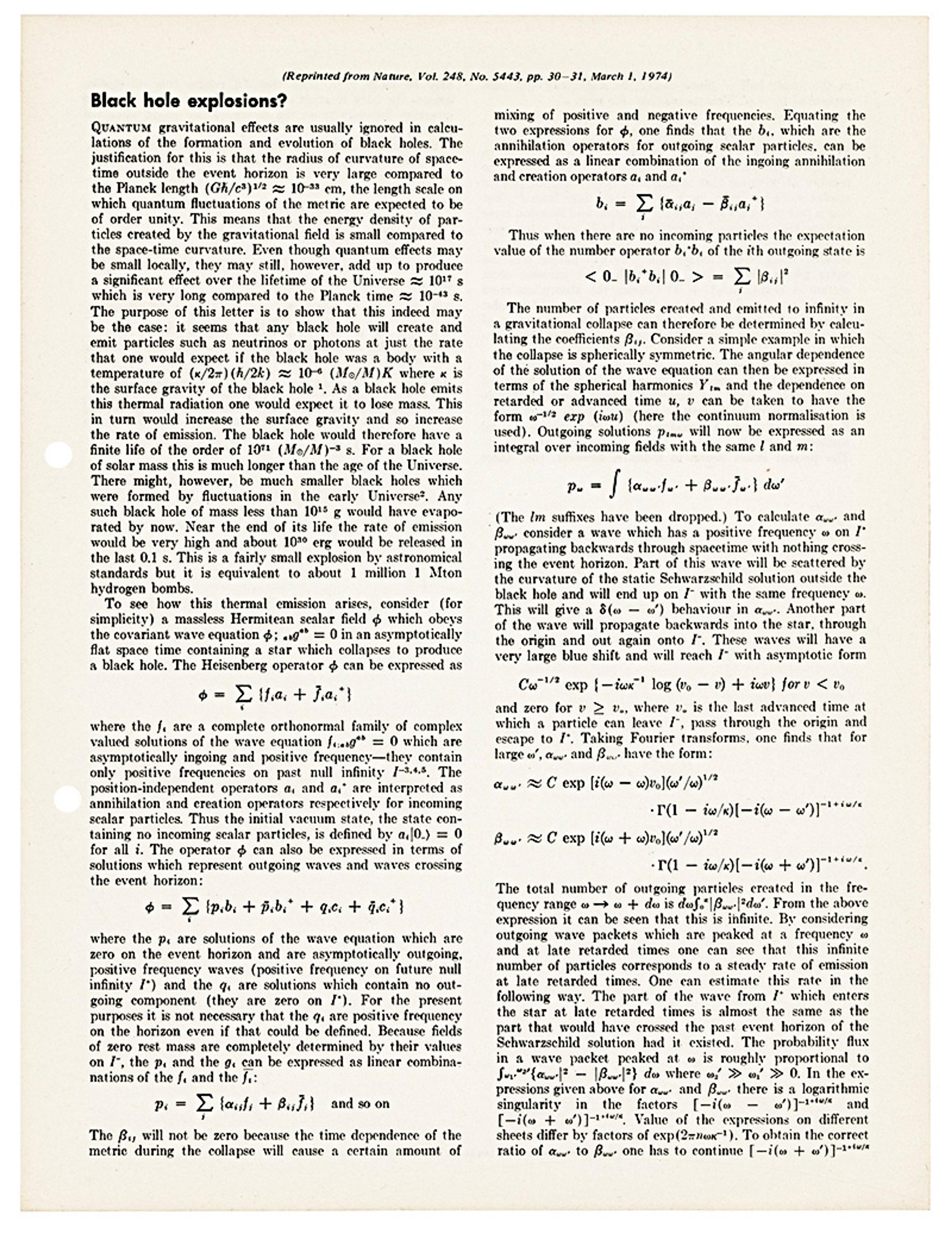
Stephen Hawking’s 1974 paper in Nature. Photo courtesy Christie’s auctions
According to the paper, a black hole with a mass equivalent to our Sun would take an eternity to evaporate. However, Hawking pointed out there might be tinier black holes, formed by fluctuations in the early Universe and, near the end of their life, emissions from these primordial black holes would represent ‘a fairly small explosion by astronomical standards but it is equivalent to about 1 million 1 Mton [megaton] hydrogen bombs’.
At that time, new satellites with sensitive detectors were being lofted into space, which would be able to detect such explosions, and Hawking drafted his paper in the hope of quick observational confirmation. Alas, there is still no definite evidence. That does not mean that the theory is wrong, however: it is just that these primordial black holes are thought to be rare. Astronomers are still searching.
Although the formulation of the equation on his tombstone would have been obvious to physicists who had read Hawking’s first papers, its first formal appearance would have to wait until the abstract of a paper in Physical Review D in 1976, written with Jim Hartle at the University of California, Santa Barbara. The mathematical expression shows the temperature of Hawking radiation given off by a black hole that is not rotating:
T=ℏc3/8πGMk
T stands for temperature; ℏ for Planck’s constant, used in quantum mechanics; c is the speed of light, used in relativity theory; 8π helps us to grasp the black hole’s spherical nature; G is Newton’s constant to introduce gravity; M stands for the mass of the black hole, and k for Boltzmann’s constant, used in thermodynamics to relate energy to temperature for individual particles. What this adds up to is that the temperature is inversely proportional to the black hole’s mass, which means that teeny black holes are larger emitters of radiation than whoppers.
The black hole sheds mass, evaporates and shines. Over its finite lifespan, it rots from the outside in
The reason why black holes emit Hawking radiation, in defiance of relativity, is down to a peculiar consequence of quantum theory: empty space is not empty at all. According to Heisenberg’s uncertainty principle, when you examine something, there is always intrinsic uncertainty as to what you are looking at. This goes for empty space too: what you think is a void is in fact alive with particle-antiparticle pairs that constantly pop in and out of existence.
At an event horizon, a black hole’s gravitational point of no return, Hawking realised that a pair’s virtual particles can be separated, with one sucked in, and the other released, so the black hole loses a little of its energy, and therefore some of its mass (mass and energy are of course related by Einstein’s most famous equation E = mc2). As a result, the black hole sheds mass, evaporates and shines. Over its finite lifespan, it rots from the outside in.
Eventually, however, Hawking became doubtful he would see direct proof of his profound insight: the amount of Hawking radiation from each black hole is predicted to be so small, it is impossible to detect (with current technology) among the radiation coming from all other cosmic objects. Even so, there are what are called solid state analogues, ‘black holes in a lab’, made of Bose-Einstein condensates (a ‘fifth state of matter’), or optical fibres, or even flowing water, which can still be used to test his ideas.
Paradoxes, where puzzling contradictions emerge, are of fascination to physicists because they highlight flaws in thinking and can pave the way for deeper insights. Over many decades, Hawking would struggle with one puzzling implication of his equation that became known as the ‘black hole information paradox’. This remains one of the greatest mysteries facing theoretical physicists today.
The paradox arises because entropy is linked to information: the more disordered that something is (and the higher the entropy), the more information is required to describe it. Imagine, for example, a string of 24 letters. If they are all the same, say an ‘A’, then it is ordered, low in entropy, and all we need is to say is ‘only As’. But if the string is a random selection of letters, and high in entropy, then every letter must be spelled out: this requires more information.
No matter what you toss into a black hole, from a rocket to a pile of books of the same mass, its Hawking radiation will stay the same, as if the black hole is oblivious to what it has consumed. Moreover, as the black hole evaporates as it gives off Hawking radiation, it eventually disappears, along with all the information it once carried.
The paradox arises because of a key concept in quantum mechanics called unitarity which, loosely speaking, says that anything that can happen can be undone, hence information cannot be fundamentally lost. So, if the information did not leak out with the Hawking radiation, what happened to it?
‘He set the agenda for one of the important problems in physics for decades’
That question is reflected in a bet between Hawking and his friends at Caltech, a copy of which was in his office. On 6 February 1997, they signed the bet (Hawking used his thumbprint), which revolved around how to resolve the paradox: Thorne, who would share the 2017 Nobel prize for his work on gravitational waves, and Hawking believed that information is destroyed. But John Preskill, an American theoretical physicist, bet that the information could be recovered in principle. The winner would receive an encyclopaedia of their choice, ‘from which information can be recovered at will’, according to the document.
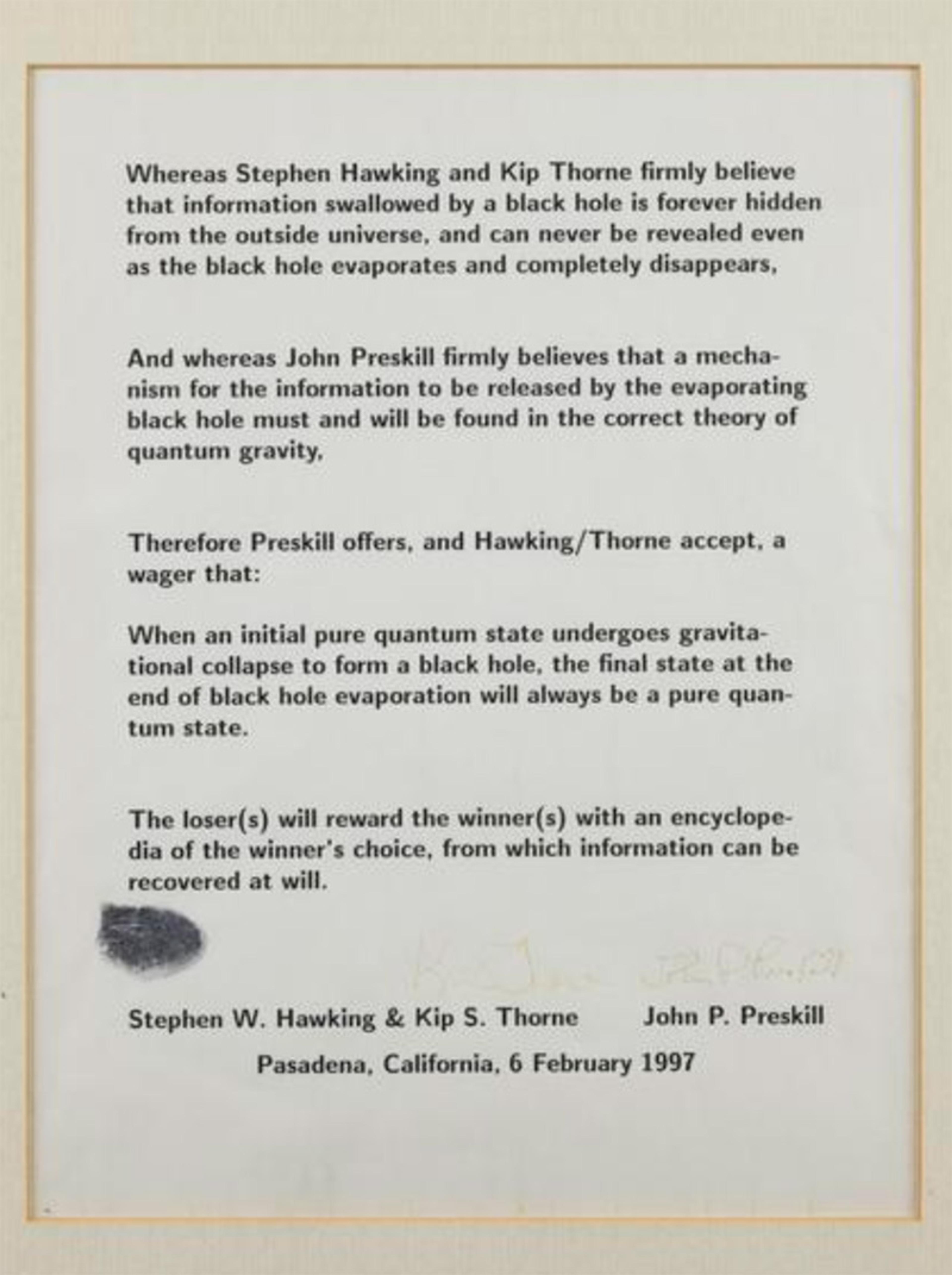
A copy of the bet between Stephen Hawking, Kip Thorne and John Preskill. Photo courtesy the Stephen Hawking Estate/Science Museum Group © The Board of Trustees of the Science Museum
Many have tried to solve the paradox. Work by Gerard ’t Hooft at Utrecht University, Leonard Susskind at Stanford University and Juan Maldacena at the Institute for Advanced Study in Princeton, among others, suggested that information swallowed by a black hole can be encoded on its surface, or event horizon. Eventually, these arguments helped sway Hawking. On 21 July 2004 in Dublin, he conceded and presented Preskill with a copy of Total Baseball, The Ultimate Baseball Encyclopedia.
Today, many physicists believe that information escapes from inside a black hole, albeit the details remain appropriately fuzzy. As Samuel Braunstein of the University of York, one of the many who have wrestled with the paradox, told me: ‘Although many claims have been made recently, based around ingenious ideas such as “entanglement islands” (entanglement is a key quantum phenomenon that links the fate of particles) and “quantum hair”, the general verdict is that we have not cracked it yet.’
Farmelo added: ‘Stephen was first to understand clearly that information flow in the region of a black hole poses a fundamental challenge to our understanding of the laws of physics. In doing this, he set the agenda for one of the important problems in physics for decades.’
When Hawking’s ashes were interred in the Scientists’ Corner at Westminster Abbey in June 2018, his Caithness slate gravestone depicted a black hole as a swirl of rings surrounding a darker central ellipse. Intersecting lines showed the dimensions of space and time and, of course, there in all its glory was his little equation that showed black holes don’t live forever.
Around 30,000 people had requested to be present, far more than could fit into the Abbey, but I doubt his precious equation meant much to most of them. He was inspirational in other ways that made him unique: he was a brilliant communicator, with A Brief History of Time (1988) selling millions of copies; he had been the subject of a Hollywood biopic; and, as impressive as his other achievements, he had stubbornly wrung the most out of life, while never complaining about the crushing burden of his motor neurone disease.
As we attended his memorial ceremony, the European Space Agency beamed a signal from a 35-metre antenna in Spain towards the nearest known black hole. The broadcast carried Hawking’s final message, in which he had described ‘my life travelling across the universe inside my mind’, which we had listened to in silence at the Abbey. One day in the year 5518, a faint signal carrying Hawking’s last words will touch his lifelong obsession, the inspiration for his little equation and his most influential research.





